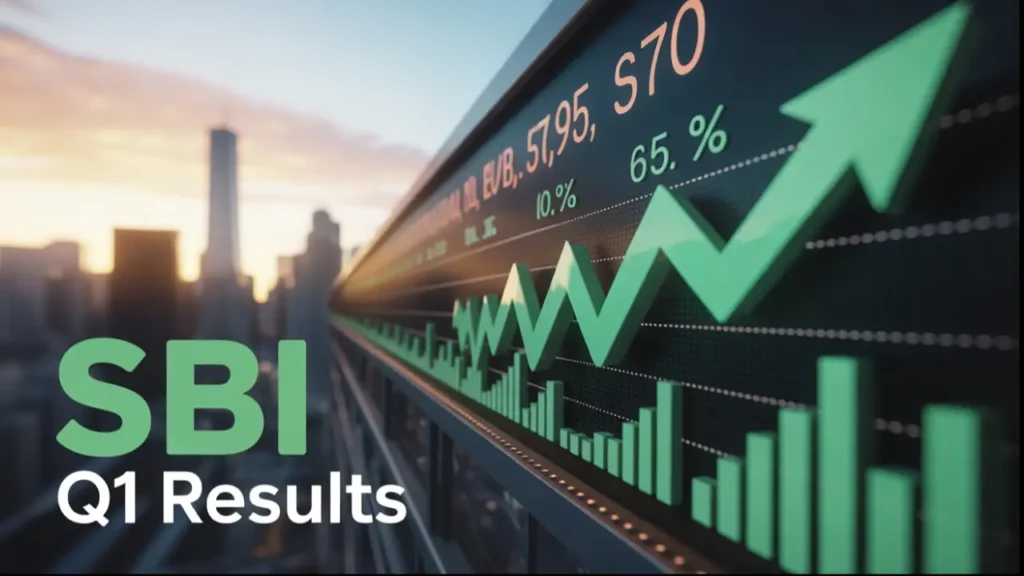State Bank of India (SBI), the country’s largest lender, has reported a solid set of numbers for the first quarter of the financial year 2025–26. The bank’s standalone net profit jumped 12% year-on-year to ₹19,160 crore, compared to ₹17,035 crore in the same quarter last year.
The result came in much stronger than what analysts had expected. Market estimates had placed the profit closer to ₹17,095 crore, but SBI outperformed those predictions. Despite this strong financial showing, the bank’s share price hardly moved, with investors showing little excitement in the immediate aftermath of the results.

SBI Profit Boosted by Treasury Gains and Lower Provisions
SBI’s earnings received a major lift from a significant rise in treasury income and lower provisioning costs. According to data reported by Reuters, the bank’s net interest income (NII) – which represents the difference between interest earned and interest paid – dipped slightly by 0.1% year-on-year to ₹41,072 crore.
However, the bank’s pre-provision operating profit (PPOP) saw healthy growth, rising 15.5% to ₹30,544 crore. The real standout was “other income,” which jumped sharply by 55.4% to ₹17,345 crore. This was mainly due to gains from treasury operations, where SBI benefited from favorable market movements in bonds and other financial instruments.
Provisions for bad loans and contingencies were also lower, helping boost net profit. This reduction came at a time when the bank’s asset quality remained steady and showed improvement in some areas.
Asset Quality and Loan Growth Show Positive Signs
SBI’s asset quality remained one of the bright spots in the Q1 report. Gross non-performing assets (NPAs) stood at around 1.83%, better than the 2.21% level recorded a year ago. Net NPAs were steady at 0.47%, indicating that the bank has managed to keep its bad loans in check.
The lender also reported steady growth in both advances and deposits, with each expanding by roughly 11–12% over the year. This growth was supported by a balanced expansion across small and medium enterprises (SME), agriculture, retail, and corporate loan segments.
SBI’s broad loan book performance suggests that the bank is well-positioned to tap into India’s growing demand for credit. The diversification across different sectors reduces the risk of overexposure to any single market and gives the bank a more stable foundation for future growth.
Market Response Remains Muted
In contrast to the upbeat earnings numbers, the stock market’s reaction was rather subdued. On August 7, 2025, SBI’s share price rose a barely noticeable 0.01%, closing at ₹805.25. This was despite the broader market showing a modest upward trend that day.
A day earlier, on August 6, the stock had slipped 0.56% to ₹805.15. Even so, it still outperformed several peer banks while the Sensex index dropped by 0.21%. By mid-day on August 8, after the Q1 results were announced, SBI shares were trading slightly lower at around ₹802.
Market experts suggest that the lack of excitement may be due to the fact that much of the strong performance was driven by treasury gains, which can be volatile and may not repeat every quarter. Investors might also be waiting for signs of stronger growth in the bank’s core lending business before reacting more positively.
Conclusion
While the muted market response may have disappointed some shareholders, SBI’s Q1 results show the bank remains on a strong financial footing. The steady improvement in asset quality, healthy growth in loan and deposit books, and disciplined provisioning suggest that SBI is well-prepared for the challenges of the coming quarters.
If the bank can sustain its growth in core lending areas and keep asset quality under control, it could continue to deliver solid profits. However, treasury gains may not always be as strong as in Q1, making it important for the bank to maintain momentum in its primary business activities.
For now, SBI’s management can take comfort in delivering a performance that beat market expectations and showcased resilience in a challenging economic environment. Investors, however, seem to be in “wait and watch” mode—looking for sustained proof before driving the share price higher.
F.A.Q.
– How much profit did SBI make in Q1 FY26?
SBI made a net profit of ₹19,160 crore in the first quarter of FY26, which is 12% higher than the same period last year.
– Why did SBI’s profit increase this quarter?
The profit grew mainly due to higher treasury income and lower provisions for bad loans, even though net interest income was slightly lower.
– How is SBI’s asset quality now?
SBI’s gross NPA improved to about 1.83% from 2.21% last year, and net NPA stayed steady at 0.47%.
– Did SBI’s share price rise after the results?
No, the share price barely moved. On August 7, it closed at ₹805.25, only 0.01% higher, and later traded slightly lower after the results.
– What is the outlook for SBI in the coming quarters?
SBI is in a strong position with good asset quality and loan growth, but future profits may depend more on core lending growth than on treasury gains.
Also read:-